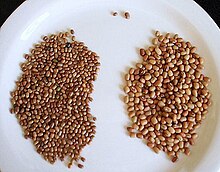| Vigna aconitifolia | |
|---|---|

| |
| Scientific classification | |
| Kingdom: | Plantae |
| Clade: | Tracheophytes |
| Clade: | Angiosperms |
| Clade: | Eudicots |
| Clade: | Rosids |
| Order: | Fabales |
| Family: | Fabaceae |
| Subfamily: | Faboideae |
| Genus: | Vigna |
| Species: | V. aconitifolia
|
| Binomial name | |
| Vigna aconitifolia (Jacq.) Marechal
| |
| Synonyms | |
|
Phaseolus aconitifolius Jacq. | |
Vigna aconitifolia is a drought-resistant legume, commonly grown in arid and semi-arid regions of India. It is commonly called mat bean, moth bean, matki or dew bean. The pods, sprouts and protein-rich seeds of this crop are commonly consumed in India. Moth bean can be grown on many soil types, and can also act as a pasture legume.
Moth bean is a creeping annual herbaceous plant which grows to approximately 40 cm high. Yellow flowers on its hairy and densely packed branches develop into yellow-brown pods, 2 to 3 inches in length[1] The seeds of these pods contain approximately 22–24% protein.[2]
Due to its drought-resistant qualities, its ability to combat soil erosion and its high protein content, moth bean has been identified as possibly a more significant food source in the future.[3] It has been suggested that its suitability as a grain legume in semi-arid Africa should be further investigated.[1]
- ^ a b Brink, M. & Jansen, P.C.M., 2006. Vigna aconitifolia (Jacq.) Maréchal. [Internet] Record from PROTA4U. Brink, M. & Belay, G. (Editors). PROTA (Plant Resources of Tropical Africa / Ressources végétales de l'Afrique tropicale), Wageningen, Netherlands. <"Prota4U". Archived from the original on November 8, 2013. Retrieved October 20, 2013.>. Accessed 15 November 2013.
- ^ Stevens, J. (1994). Bean, Moth —Vigna aconitifolia (Jacq.) Marechal (HS554). Gainesville: University of Florida Institute of Food and Agricultural Sciences. Retrieved October 31, 2013 from [1]
- ^ Adsule, R. N. (1996). Moth bean (Vigna aconitifolia (Jacq.) Marechal). In Food and Feed from Legumes and Oilseeds (pp. 203–205). Springer US